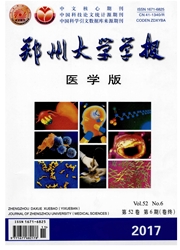

 中文摘要:
中文摘要:
目的:发现氟喹诺酮由抗菌活性转化为抗肿瘤活性的有效结构修饰策略。方法:用噁二唑杂环作为环丙沙星C-3羧基的生物电子等排体,硫乙酰腙为其功能修饰侧链,合成10个新氟喹诺酮C-3噁二唑硫乙酰腙目标化合物,其结构经元素分析和光谱数据确证,并评价其体外对SMMC-7721、L1210和HL60等3种癌细胞的抗增殖作用。结果:目标物的抗肿瘤活性高于母体化合物,尤其是苯环含有氟原子和硝基的化合物,其抗肿瘤作用与对照阿霉素相当。结论:噁二唑杂环可用于氟喹诺酮C-3羧基的等排体,被功能基侧链修饰有利于提高抗肿瘤活性。
 英文摘要:
英文摘要:
Aim : To discover an efficient strategy for a conversion of antibacterial fluoroquinolones into antitumor fluo- roquinolones. Methods: Ten novel fluoroquinolone C-3 oxadiazole sulfanylacetylhydrazone derivatives were designed and synthesized with an oxadiazole ring as the C-3 bioisostere modified by a functionalized sulfanylacetylhydrazone side-chain from ciprofloxacin, respectively. The structures of the title compounds were characterized by elemental analysis and spectral data, and the in vitro antitumor activity against SMMC-7721, L1210 and HL60 cell lines was evaluated by MTT assay. Re- sults: The title compounds demonstrated more antiproliferative activity than the parent. In particular, compounds bearing a fluorine atom or nitro group attached to benzene ring were comparable to the control doxorubicin. Conclusion: An azole modified with functionalized side-chain as the bioisosteric replacement of the C-3 carboxylic group is favorable to improvement of antitumor activity.
 同期刊论文项目
同期刊论文项目
 同项目期刊论文
同项目期刊论文
 Part II: Design, synthesis and antitumor action of C3/C3 bis-fluoroquinolones linked-cross 2,5-[1,3,
Part II: Design, synthesis and antitumor action of C3/C3 bis-fluoroquinolones linked-cross 2,5-[1,3, Synthesis and antitumor evaluation of fluoroquinolone C3 fused heterocycles (II): From triazolothiad
Synthesis and antitumor evaluation of fluoroquinolone C3 fused heterocycles (II): From triazolothiad Design, synthesis and antitumor activity of C3/C3 bis- fluoroquinolones cross-linked with [1,2,4]tri
Design, synthesis and antitumor activity of C3/C3 bis- fluoroquinolones cross-linked with [1,2,4]tri Synthesis and antitumor evaluation of C3/C3 fluoroquinolone dimmers (I): Tethered with a fused heter
Synthesis and antitumor evaluation of C3/C3 fluoroquinolone dimmers (I): Tethered with a fused heter Design, synthesis and antitumor activity of C-3/C-3 bis-fluoroquinolones cross-linked with [1,24]tri
Design, synthesis and antitumor activity of C-3/C-3 bis-fluoroquinolones cross-linked with [1,24]tri 期刊信息
期刊信息
